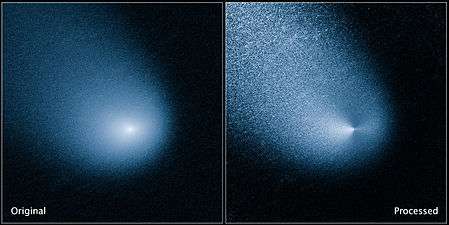2014 XL7
| Discovery[1] | |
|---|---|
| Discovered by | Mt. Lemmon Survey (G96) |
| Discovery date | 11 December 2014 |
| Designations | |
| MPC designation | 2014 XL7 |
|
Apollo, NEO, PHA[2] | |
| Orbital characteristics[2] | |
| Epoch 13 January 2016 (JD 2457400.5) | |
| Uncertainty parameter 3 | |
| Observation arc | 475 days (1.30 yr) |
| Aphelion | 2.5362 AU (379.41 Gm) (Q) |
| Perihelion | 0.77211 AU (115.506 Gm) (q) |
| 1.6542 AU (247.46 Gm) (a) | |
| Eccentricity | 0.53323 (e) |
| 2.13 yr (777.08 d) | |
| 235.20° (M) | |
| 0° 27m 47.772s / day (n) | |
| Inclination | 7.5012° (i) |
| 74.514° (Ω) | |
| 250.71° (ω) | |
| Earth MOID | 0.00258894 AU (387,300 km) |
| Jupiter MOID | 2.83909 AU (424.722 Gm) |
| Physical characteristics | |
| Dimensions |
~230 meters[3] 170 – 380 meters[4] |
| 21.0[2] | |
|
| |
2014 XL7 (also written 2014 XL7) was the most dangerous potentially hazardous asteroid discovered in 2014 that remained on the Sentry Risk Table at the end of 2014.[5] The Apollo near-Earth asteroid is estimated to be roughly 230 meters in diameter and had a cumulative 1 in 83000 chance of impacting Earth on 4–5 June between the years 2048 and 2084.[3] It was removed from the Sentry Risk Table on 15 January 2015 using JPL solution 9 with an observation arc of 35 days.[6]
On 1 September 2014 the asteroid passed about 0.259 AU (38,700,000 km; 24,100,000 mi) from Earth,[7] but at that time the asteroid had an apparent magnitude of 25 and was roughly 25 degrees from the Sun.[8] It was discovered on 11 December 2014 by the Mount Lemmon Survey at an apparent magnitude of 20 using a 1.5-meter (59 in) reflecting telescope.[1] The asteroid has an observation arc of 35 days with an uncertainty parameter of 6.[2] The asteroid was last observed on 15 January 2015,[2] and is still being actively observed to better constrain the orbit. The asteroid will not drop below magnitude 25 until March 2015.[9]
With an absolute magnitude of 21,[2] the asteroid is about 170–380 meters in diameter.[4]
With an observation arc of 19 days, it had a cumulative Palermo Scale rating of –2.85 and was briefly the 9th most dangerous asteroid known.[5] It was calculated that on 4 June 2065 there was a 1 in 270000 chance of impact and on 4 June 2076 there was a 1 in 137000 chance of impact.[3] On 15 January 2015 the asteroid was recovered by Cerro Paranal Observatory which extended the observation arc to 35 days,[10] and 2014 XL7 was removed from the Sentry Risk Table.[6]
References
- 1 2 "MPEC 2014-X76 : 2014 XL7". IAU Minor Planet Center. 2014-12-15. Retrieved 2015-01-01. (K14X07L)
- 1 2 3 4 5 6 "JPL Small-Body Database Browser: (2014 XL7)" (last observation: 2014-12-30; arc: 19 days). Jet Propulsion Laboratory. Retrieved 4 April 2016.
- 1 2 3 "Earth Impact Risk Summary: 2014 XL7". WayBack Machine: NASA/JPL Near-Earth Object Program Office. 2014-12-31. Archived from the original on December 31, 2014. Retrieved 2015-01-01.
- 1 2 "Absolute Magnitude (H)". NASA/JPL. Retrieved 2015-01-01.
- 1 2 "Sentry Risk Table". WayBack Machine: NASA/JPL Near-Earth Object Program Office. 2014-12-31. Archived from the original on December 31, 2014. Retrieved 2015-01-01. (PS=–2.85)
- 1 2 "Date/Time Removed". NASA/JPL Near-Earth Object Program Office. Retrieved 2015-01-16.
- ↑ "JPL Close-Approach Data: (2014 XL7)" (last observation: 2014-12-30; arc: 19 days). Retrieved 2015-01-01.
- ↑ "2014XL7 Ephemerides for 1 September 2014". NEODyS (Near Earth Objects – Dynamic Site). Retrieved 2015-01-01.
- ↑ "2014XL7 Ephemerides for 1 January 2015 through 1 April 2015". NEODyS (Near Earth Objects – Dynamic Site). Retrieved 2014-12-12.
- ↑ "2014 XL7 Orbit". IAU Minor Planet Center. Retrieved 2015-01-16.
External links
- 2014 XL7 at the JPL Small-Body Database



